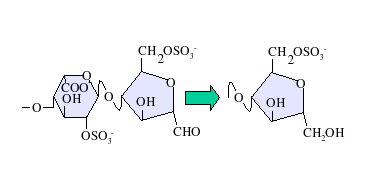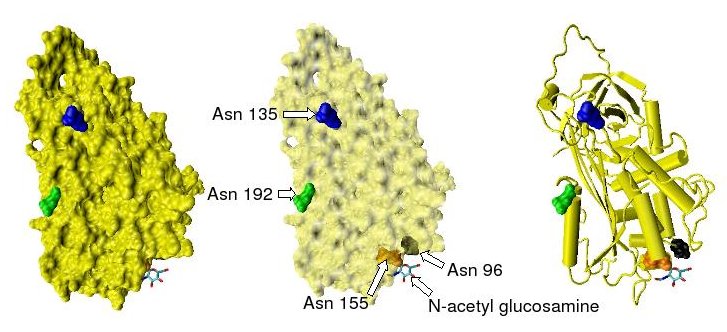|
Sulodexide
Sulodexide, traded as Aterina, is a highly purified mixture of glycosaminoglycans composed of low molecular weight heparin (80%) and dermatan sulfate (20%). Pharmacology The low molecular weight of both sulodexide fractions allows for extensive oral absorption compared to unfractionated heparin. The pharmacological effects of sulodexide differ substantially from other glycosaminoglycans and are mainly characterized by a prolonged half-life and reduced effect on global coagulation and bleeding parameters. Due to the presence of both glycosaminoglycan fractions, sulodexide potentiates the antiprotease activities of both antithrombin III and heparin cofactor II simultaneously. Uses Clinically, sulodexide is used for the prophylaxis and treatment of thromboembolic diseases; however, recent research has also demonstrated the beneficial effects of sulodexide in animal models of reperfusion injury and the treatment of diabetic nephropathy. In combination with melatonin, sulodexide has b ... [...More Info...] [...Related Items...] OR: [Wikipedia] [Google] [Baidu] |
Dermatan Sulfate
Dermatan sulfate is a glycosaminoglycan (formerly called a mucopolysaccharide) found mostly in skin, but also in blood vessels, heart valves, tendons, and lungs. It is also referred to as chondroitin sulfate B, although it is no longer classified as a form of chondroitin sulfate by most sources. The formula is C14H21NO15S. This carbohydrate is composed of linear polymers of disaccharide units that contain, N-acetyl galactosamine (GalNAc) and iduronic acid (IdoA). These repeating units are sulfated at a variety of positions. Dermatan sulfate is a component of the compound sulodexide. Function Dermatan sulfate may have roles in coagulation, cardiovascular disease, carcinogenesis, infection, wound repair, maintains the shape of galactosamine 4-sulfate skin and fibrosis. Pathology Dermatan sulfate accumulates abnormally in several of the mucopolysaccharidosis disorders. An excess of dermatan sulfate in the mitral valve is characteristic of myxomatous degeneration of the leaflet ... [...More Info...] [...Related Items...] OR: [Wikipedia] [Google] [Baidu] |
Glycosaminoglycans
Glycosaminoglycans (GAGs) or mucopolysaccharides are long, linear polysaccharides consisting of repeating disaccharide units (i.e. two-sugar units). The repeating two-sugar unit consists of a uronic sugar and an amino sugar, except in the case of the sulfated glycosaminoglycan keratan, where, in place of the uronic sugar there is a galactose unit. GAGs are found in vertebrates, invertebrates and bacteria. Because GAGs are highly polar molecules and attract water; the body uses them as lubricants or shock absorbers. Mucopolysaccharidoses are a group of metabolic disorders in which abnormal accumulations of glycosaminoglycans occur due to enzyme deficiencies. Production Glycosaminoglycans vary greatly in molecular mass, disaccharide structure, and sulfation. This is because GAG synthesis is not template driven, as are proteins or nucleic acids, but constantly altered by processing enzymes. GAGs are classified into four groups, based on their core disaccharide structures. Hepa ... [...More Info...] [...Related Items...] OR: [Wikipedia] [Google] [Baidu] |
Low Molecular Weight Heparin
Low-molecular-weight heparin (LMWH) is a class of anticoagulant medications. They are used in the prevention of blood clots and treatment of venous thromboembolism (deep vein thrombosis and pulmonary embolism) and in the treatment of myocardial infarction. Heparin is a naturally occurring polysaccharide that inhibits coagulation, the process that leads to thrombosis. Natural heparin consists of molecular chains of varying lengths, or molecular weights. Chains of varying molecular weights, from 5000 to over 40,000 Daltons, make up polydisperse pharmaceutical-grade heparin. LMWHs, in contrast, consist of only short chains of polysaccharide. LMWHs are defined as heparin salts having an average molecular weight of less than 8000 Da and for which at least 60% of all chains have a molecular weight less than 8000 Da. These are obtained by various methods of fractionation or depolymerisation of polymeric heparin. Heparin derived from natural sources, mainly porcine intestine or bovine l ... [...More Info...] [...Related Items...] OR: [Wikipedia] [Google] [Baidu] |
Heparin
Heparin, also known as unfractionated heparin (UFH), is a medication and naturally occurring glycosaminoglycan. Since heparins depend on the activity of antithrombin, they are considered anticoagulants. Specifically it is also used in the treatment of heart attacks and unstable angina. It is given intravenously or by injection under the skin. Other uses for its anticoagulant properties include inside blood specimen test tubes and kidney dialysis machines. Common side effects include bleeding, pain at the injection site, and low blood platelets. Serious side effects include heparin-induced thrombocytopenia. Greater care is needed in those with poor kidney function. Heparin is contraindicated for suspected cases of vaccine-induced pro-thrombotic immune thrombocytopenia (VIPIT) secondary to SARS-CoV-2 vaccination, as heparin may further increase the risk of bleeding in an anti-PF4/heparin complex autoimmune manner, in favor of alternative anticoagulant medications (such as arg ... [...More Info...] [...Related Items...] OR: [Wikipedia] [Google] [Baidu] |
Antithrombin III
Antithrombin (AT) is a small glycoprotein that inactivates several enzymes of the coagulation system. It is a 432-amino-acid protein produced by the liver. It contains three disulfide bonds and a total of four possible glycosylation sites. α-Antithrombin is the dominant form of antithrombin found in blood plasma and has an oligosaccharide occupying each of its four glycosylation sites. A single glycosylation site remains consistently un-occupied in the minor form of antithrombin, β-antithrombin. Its activity is increased manyfold by the anticoagulant drug heparin, which enhances the binding of antithrombin to thrombin, factor IIa (prothrombin) and factor Xa. Nomenclature Antithrombin is also termed antithrombin III (AT III). The designations antithrombin I through to antithrombin IV originate in early studies carried out in the 1950s by Seegers, Johnson and Fell. Antithrombin I (AT I) refers to the absorption of thrombin onto fibrin after thrombin has activated fibrinogen. He ... [...More Info...] [...Related Items...] OR: [Wikipedia] [Google] [Baidu] |
Heparin Cofactor II
Heparin cofactor II (HCII), a protein encoded by the SERPIND1 gene, is a coagulation factor that inhibits IIa, and is a cofactor for heparin and dermatan sulfate ("minor antithrombin"). The product encoded by this gene is a serine protease inhibitor which rapidly inhibits thrombin in the presence of dermatan sulfate or heparin. The gene contains five exons and four introns. This protein shares homology with antithrombin III and other members of the alpha-1 antitrypsin superfamily. Mutations in this gene are associated with heparin cofactor II deficiency. Heparin cofactor II deficiency can lead to increased thrombin generation and a hypercoagulable state. A purification experiment of heparin cofactor II was performed in 1981, in which it was discovered that the purified version of the protein consists of a single polypeptide chain. Further experimentation demonstrated that whether β-Mercaptoethanol is present does not affect HCII's activity in gel electrophoresis. β-Mercaptoeth ... [...More Info...] [...Related Items...] OR: [Wikipedia] [Google] [Baidu] |
Reperfusion Injury
Reperfusion injury, sometimes called ischemia-reperfusion injury (IRI) or reoxygenation injury, is the tissue damage caused when blood supply returns to tissue ('' re-'' + '' perfusion'') after a period of ischemia or lack of oxygen (anoxia or hypoxia). The absence of oxygen and nutrients from blood during the ischemic period creates a condition in which the restoration of circulation results in inflammation and oxidative damage through the induction of oxidative stress rather than (or along with) restoration of normal function. Reperfusion injury is distinct from cerebral hyperperfusion syndrome (sometimes called "Reperfusion syndrome"), a state of abnormal cerebral vasodilation. Mechanisms Reperfusion of ischemic tissues is often associated with microvascular injury, particularly due to increased permeability of capillaries and arterioles that lead to an increase of diffusion and fluid filtration across the tissues. Activated endothelial cells produce more reactive oxygen sp ... [...More Info...] [...Related Items...] OR: [Wikipedia] [Google] [Baidu] |
Diabetic Nephropathy
Diabetic nephropathy, also known as diabetic kidney disease, is the chronic loss of kidney function occurring in those with diabetes mellitus. Diabetic nephropathy is the leading causes of chronic kidney disease (CKD) and end-stage renal disease (ESRD) globally. The triad of protein leaking into the urine (proteinuria or albuminuria), rising blood pressure with hypertension and then falling renal function is common to many forms of CKD. Protein loss in the urine due to damage of the glomeruli may become massive, and cause a low serum albumin with resulting generalized body swelling (edema) so called nephrotic syndrome. Likewise, the estimated glomerular filtration rate (eGFR) may progressively fall from a normal of over 90 ml/min/1.73m2 to less than 15, at which point the patient is said to have end-stage renal disease. It usually is slowly progressive over years. Pathophysiologic abnormalities in diabetic nephropathy usually begin with long-standing poorly controlled blood g ... [...More Info...] [...Related Items...] OR: [Wikipedia] [Google] [Baidu] |
Melatonin
Melatonin is a natural product found in plants and animals. It is primarily known in animals as a hormone released by the pineal gland in the brain at night, and has long been associated with control of the sleep–wake cycle. In vertebrates, melatonin is involved in synchronizing circadian rhythms, including sleep–wake timing and blood pressure regulation, and in control of seasonal rhythmicity including reproduction, fattening, moulting and hibernation. Many of its effects are through activation of the melatonin receptors, while others are due to its role as an antioxidant. In plants, it functions to defend against oxidative stress. It is also present in various foods. Melatonin was discovered in 1958. In addition to its role as a natural hormone, melatonin is used as a dietary supplement and medication in the treatment of sleep disorders such as insomnia and circadian rhythm sleep disorders; for information on melatonin as a supplement and medication, see the melatoni ... [...More Info...] [...Related Items...] OR: [Wikipedia] [Google] [Baidu] |
Tinnitus
Tinnitus is the perception of sound when no corresponding external sound is present. Nearly everyone experiences a faint "normal tinnitus" in a completely quiet room; but it is of concern only if it is bothersome, interferes with normal hearing, or is associated with other problems. While often described as a ringing, it may also sound like a clicking, buzzing, hissing or roaring. It may be soft or loud, low- or high- pitched, and may seem to come from one or both ears or from the head itself. In some people, it may interfere with concentration, and in some cases is associated with anxiety and depression. Tinnitus is usually associated with a degree of hearing loss and decreased comprehension of speech in noisy environments. It is common, affecting about 10–15% of people. Most, however, tolerate it well, and it is a significant problem in only 1–2% of all people. It can trigger a fight-or-flight response, as the brain may perceive it as dangerous and important. The word ' ... [...More Info...] [...Related Items...] OR: [Wikipedia] [Google] [Baidu] |
Chronic Venous Insufficiency
Chronic venous insufficiency (CVI) is a medical condition in which blood pools in the veins, straining the walls of the vein. The most common cause of CVI is superficial venous reflux which is a treatable condition. As functional venous valves are required to provide for efficient blood return from the lower extremities, this condition typically affects the legs. If the impaired vein function causes significant symptoms, such as swelling and ulcer formation, it is referred to as chronic venous disease. It is sometimes called ''chronic peripheral venous insufficiency'' and should not be confused with post-thrombotic syndrome in which the deep veins have been damaged by previous deep vein thrombosis. Most cases of CVI can be improved with treatments to the superficial venous system or stenting the deep system. Varicose veins for example can now be treated by local anesthetic endovenous surgery. Rates of CVI are higher in women than in men. Other risk factors include genetics, smok ... [...More Info...] [...Related Items...] OR: [Wikipedia] [Google] [Baidu] |




